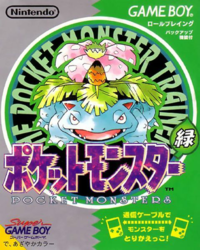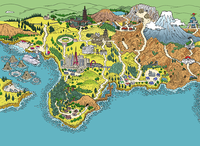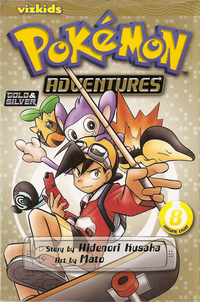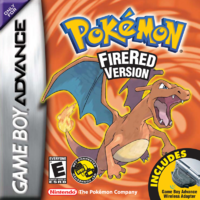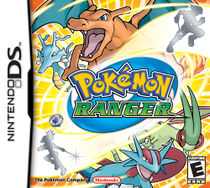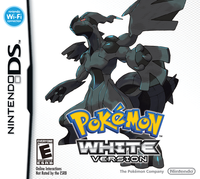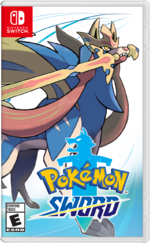History of Pokémon
| This article is a featured article. This means that it has been identified as one of the best articles produced on Bulbapedia. |
- This article is about the history of the Pokémon media franchise. For other uses of "history", see History.
The history of the Pokémon media franchise spans over two decades from when work began officially on the first game to now, and has roots even older. It started simply enough as a hobby of Satoshi Tajiri, who as a child had a fondness for catching insects and tadpoles near his home in suburban Tokyo. Over time, Tajiri decided to put his idea of catching creatures into practice, to give children the same thrills he had as a child.
Early days
With the help of Ken Sugimori and other friends, Tajiri formed Game Freak and much later the design studio known as Creatures. When Tajiri discovered the Game Boy and the Game Boy Game Link Cable, it gave him the image of insects traveling along the wire. Tajiri was also heavily influenced by the Ultraman fantasy television show, Ultra Seven, in which the protagonist used giant monsters contained within small capsules to help him fight. Together, these two sources gave him the idea for a new game called Capsule Monsters.[1] After several failed attempts at pitching this idea to Nintendo, Tajiri's new friend Shigeru Miyamoto pitched it to the company, and Nintendo began to fund the project, spending six years developing the games that would become a worldwide sensation. Due to trademarking issues, the name "Capsule Monsters" was changed to "Pocket Monsters".[2]
The original artwork for the games was drawn by Tajiri's friend, artist Ken Sugimori, while the music and sound effects were composed by Junichi Masuda.
After debugging was completed, Shigeki Morimoto programmed Mew into the game. However, Game Freak planned to keep the 151st Pokémon hidden from the public unless it was needed for a post-launch event.[3]
The project nearly drove Game Freak to bankruptcy. Five employees quit due to the financial conditions, and Tajiri worked many unpaid hours.[4]
Generation I
Taking over Japan
The first Pokémon games, Pokémon Red and Green Versions, came to the Nintendo Game Boy system in Japan on February 27, 1996, which was the fulfillment of Satoshi Tajiri's dream and allowed people of all ages to catch, train and trade 151 creatures and become a Pokémon Master.
Initially, the Pokémon games had modest sales. However, after players discovered Mew in the games, the magazine CoroCoro announced a "Legendary Pokémon Offer" to distribute Mew to twenty entrants. The contest received 78,000 entrants, and the sales of the Pokémon games quickly increased.[5] Due to high sales, Pokémon Red and Green were swiftly followed up with Pokémon Blue, which had improved graphics and sounds.
After the games, a Pokémon Trading Card Game was developed by Media Factory with its own set of rules. The first set of cards was released on October 20, 1996, containing 102 cards, and became very popular.
The franchise also won many manga interpretations, the first being Pokémon Pocket Monsters by Kosaku Anakubo, which was first collected and published in November 1996 by Shogakukan. This was chiefly a gag manga, using crude humor and slapstick, starring a Trainer named Red and his rude Clefairy.
The popularity of the franchise also led to an anime series based on the games, premiering in Japan on April 1, 1997. The main character was a young Pokémon Trainer named Satoshi (after Satoshi Tajiri, later dubbed in English to Ash Ketchum), based on Red. Another character introduced in the first episode was Satoshi's rival, Shigeru (after Shigeru Miyamoto, later dubbed in English to Gary Oak), based on Blue.
The anime quickly became very popular, and soon a manga series based on it named The Electric Tale of Pikachu was written by Toshihiro Ono. The first volume of the series was first published on October 28, 1997. The more famous manga in the western world, however, is Pokémon Adventures, with the first volume being published in Japan on August 8, 1997. It was one of the most successful Pokémon manga, with 150,000 copies sold worldwide. It is also the longest running manga in Pokémon history based on its starting date. Several other manga series were published in that era, including Pokémon Zensho and Miho Asada's Pokémon Gotta Catch 'Em All.
In addition to these manga series, Shogakukan also published the first volume of Pokémon Wonderland, a magazine with the latest information on the franchise, on August 23, 1997. They also released a new manga series named Pokémon PiPiPi ★ Adventures (later translated to Magical Pokémon Journey), authored by Yumi Tsukirino, on March 28, 1998. The main difference in this series was that is was aimed mainly towards girls.
On April 25, 1998, the first Pokémon Center store was opened in Tokyo, a chain of official stores that specialize in Pokémon merchandise. Along the way, The Pokémon Company began its operations. Many Pokémon Center stores were opened in later years, and today there are many Pokémon Center stores across Japan, as well as one store in Singapore and Taiwan. Historically there was a Pokémon Center in New York, but in 2005 it was replaced by the Nintendo World store (later renamed Nintendo New York), although the store retained a Pokémon section.
Conquering the world
Due to Pokémon's success in Japan, the series was released overseas. Before the games were released in North America, the localization team attempted to change the Pokémon designs, fearing that the cute designs would not appeal to western gamers; however, the proposal was refused.[6][7] On the other hand, Nintendo originally did not intend to allow for localized Pokémon names (due to having to register more trademarks), but were eventually convinced by the French translation team to do so.[8] North America received Red and Blue Versions, as well as the anime, in September 1998 (the anime on the 7th and the games on the 28th), and soon everywhere else began to play the games on the Game Boy under the slogan Gotta Catch 'em All!. The Trading Card Game was also introduced to North America on January 9, 1999 by Wizards of the Coast. The Electric Tale of Pikachu became the first Pokémon manga to be translated to English when VIZ Media started publishing it on September 28, 1999.
Meanwhile in Japan in 1998, a new spin-off game, Pokémon Stadium, was released for Nintendo 64. This game featured only 42 Pokémon of the full 151. This game proved to be commercially and critically unsuccessful, though its sequel, originally planned for the Nintendo 64DD, received an international release.
The anime, on the other hand, pushed the franchise to new heights. On July 18, 1998, Mewtwo Strikes Back debuted in Japanese theaters, featuring the rare Mew and Mewtwo. In the United States, where it was released on November 10, 1999, the movie even briefly held the record for highest-grossing opening for an animated film.
Plans soon started for a game based on the popular anime and Yellow Version was released September 12, 1998 in Japan, October 25, 1999 in North America and Europe. Pokémon Yellow allowed Trainers to take on the role of Ash and travel through Kanto with anime-style graphics for each Pokémon and a Pikachu by their side, following the anime's course of events.
Expanding to spin-offs
On December 18, 1998 a Game Boy game based on the TCG was released, later arriving in North America on April 10, 2000. It was followed, only in Japan, a year later by a sequel titled Pokémon Trading Card Game 2: The Invasion of Team GR!.
The anime, as well as Pokémon Yellow, marked Pikachu as the most popular and recognized creatures in Pokémon history, turning it into the franchise's mascot. This led to a small spin-off game called Hey You, Pikachu!, which was released in Japan on December 12, 1998, and in North America on November 6, 2000. This was a virtual-pet game, utilizing the Nintendo 64's Voice Recognition Unit to let the players interact verbally with Pikachu.
When the anime finished following the games' story with Ash's defeat in the Pokémon League in January 1999, it started a new season in a new region called the Orange Islands, introducing the new main character of Tracey Sketchit. During this season's time, a second movie, The Power of One, was produced. It was first in Japanese theaters on July 17, 1999, and in North American theaters on July 21, 2000.
A non-traditional spin-off game for Nintendo 64, Pokémon Snap, was released in Japan on March 21, 1999, inviting the player (in the role of Todd) to a Pokémon photographing mission in a place called Pokémon Island. This game made its way to North America on July 27, 1999.
On April 14, 1999, a spin-off pinball game for the Game Boy Color was released, called Pokémon Pinball. This game took all the mechanics of regular pinball, with some Pokémon aspects added in. Its North American release was on June 28, 1999.
A sequel to Pokémon Stadium was also eventually released in Japan on April 30, 1999, and became a success. This game reached North America on February 29, 2000, and became known there as the original Pokémon Stadium. The twist in the Stadium series from the core series was that it featured the Pokémon in 3D.
In September 2000, the anime-based puzzle game Pokémon Puzzle League was released for Nintendo 64. This game was the only Pokémon game to be made specifically for western audiences and not be released in Japan.
However, this was not the only American-made original Pokémon material. From 2000 to 2002, an anime-based musical called Pokémon Live! was shown on stages around the world. The most memorable plot point in the musical was the revelation that Ash's mother, Delia, used to be a friend of Giovanni when they were younger. The musical isn't considered canon, but it sparked endless theories among fans regarding the identity of Ash's father.
Generation II
Winds of new beginnings
Almost since the very beginning of the series, it had been apparent that the first 151 Pokémon would not be the last. Ho-Oh was seen as early as the first episode of the anime, Togepi was owned by a main character, and others like Marill, Snubbull, and Donphan were seen in the first movie. Later, when the second generation of Pokémon was drawing nearer, others like Lugia, Slowking, and Elekid made their way to the second movie.
On November 21, 1999, Nintendo of Japan released Gold and Silver Versions for the then-new Game Boy Color. This time, Trainers were invited to the land of Johto, where 100 more Pokémon were waiting to be captured. The new games enhanced the Pokémon gaming experience by adding many new features, the most famous likely being the ability for Pokémon to have different genders, in turn allowing them to breed. A time system was also introduced, with a real-time clock allowing different events to happen during the day, at night, and in the morning, as well as on certain days of the week. Another important addition was the friendship system. Shiny Pokémon also first appeared, most notably a Red Gyarados at the Lake of Rage. Trainers could also return to Kanto and face the Gym Leaders that were present in the original games. Pokémon Gold and Silver made its way to North America on October 11, 2000.
The anime followed, of course, and Ash and his friends also arrived at Johto in an episode that aired in Japan on October 14, 1999 and in the US on October 14, 2000. Spell of the Unown: Entei was then released to theaters on July 8, 2000 in Japan and on April 6, 2001 in North America, featuring the Legendary Entei.
A new trading card set called Neo Genesis featured the first Generation II Pokémon to the Trading Card Game. It was released in Japan on December 10, 1999 and in the United States on December 16, 2000.
A sequel to Pokémon Puzzle League was released on September 21, 2000 for Game Boy Color, this time in Japan, titled Pokémon Puzzle Challenge. It made its way to North America on December 4, 2000.
On December 14, 2000, Pokémon Stadium 2, bringing the Generation II Pokémon into full 3D for the first time. This game reached North America on March 25, 2001.
Like Pokémon Yellow, a third version was made called Pokémon Crystal, which was released in Japan on December 14, 2000 and in North America on July 21, 2001. Pokémon Crystal had several notable changes from Gold and Silver. Suicune was the game mascot and the focus of the plot. Crystal was also the first portable Pokémon game to feature animations for every Pokémon. Trainers in Japan received the added bonus of being able to trade, battle, and even obtain the Legendary Pokémon Celebi wirelessly by using a cell phone to connect to the Mobile System GB. Trainers were also, for the first time, allowed to choose their character's gender.
Anime and manga in GS
On December 30, 2000, the first feature-length special of the Pokémon anime was released in Japan as a sequel to Mewtwo Strikes Back, titled Mewtwo Returns. It was later released on DVD in the United States on December 5, 2001.
In June 2000, a manga series by Muneo Saitō titled Pokémon Gold & Silver: The Golden Boys was published in Japan. This manga followed the plot of the Generation II games, before abruptly ending after three volumes with very little resolution. Another new manga series by Takashi Teshirogi based on the anime's new seasons called Ash & Pikachu was published on February 26, 2001.
Another anime movie, Celebi: The Voice of the Forest, debuted in theaters in Japan on July 7, 2001, and in North America on October 25, 2002. It featured two Legendary Pokémon prominent in Pokémon Crystal: Celebi and Suicune.
The Pokémon Adventures manga finally caught up to the second generation on August 8, 2001, when Volume 8 was published in Japan, starting the Gold, Silver & Crystal arc. This arc was much longer than the previous arcs of the series, lasting no less than 7 full volumes.
Raikou, the only member of the Legendary beasts yet to be featured in an anime movie at the time, received its own made-for-TV special, The Legend of Thunder!, on December 30, 2001. This special didn't feature Ash and his friends, but rather new characters based on the player characters of the second generation.
On July 13, 2002, the fifth and final movie of the original series, Pokémon Heroes: Latios & Latias, was released in Japanese theaters. Distributed on limited release by Miramax Films, it opened in select American theaters on May 16, 2003.
Generation III
Advancing to a new age
In July 2001 an episode of the anime aired in Japan featuring a Pokémon never previously seen - Kecleon. Soon, Kecleon and others like Wynaut, Azurill, Duskull, and Volbeat showed up in theaters in two Pikachu shorts while Wailmer, Latias, and Latios were featured in the fifth Pokémon movie. During the Silver Conference Ash battled Harrison, a Trainer from Littleroot Town in Hoenn. Professor Birch, along with other Pokémon, made a cameo in Johto Photo Finish. Through this, it became known that the next generation of Pokémon was just around the corner.
Indeed, a major overhaul of the main game series occurred when Pokémon arrived on the Game Boy Advance on November 21, 2002 when Ruby and Sapphire Versions were released in Japan. Trainers found themselves in the southern land called Hoenn where 135 new Pokémon were waiting to be discovered. The games reached North America on March 18, 2003 and had many new features, the most prominent being Pokémon Contests, Double Battles, Pokémon Abilities and Natures for each Pokémon, along with the reform of effort values and individual values. Also introduced in these versions were more types of weather and two new villainous teams, Team Magma and Team Aqua. Due to the extensive changes to the system, however, this generation was not compatible with earlier generations.
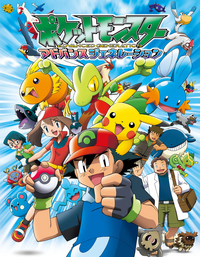
The anime began a new series, Pokémon the Series: Ruby and Sapphire, which started in Japan on the same day as the release of the games and reached North America almost a year later. A great deal was changed in this series, including the introduction of a new main character, May, based on her game counterpart. Two new movies were produced during the time in Hoenn: Jirachi: Wish Maker (which was released on July 19, 2003 in Japan and on June 1, 2004 on video and DVD in North America) and Destiny Deoxys (which was released on July 17, 2004 in Japan and on January 22, 2005 on North American television).
Around the same time of Pokémon the Series: Ruby and Sapphire, a show called Weekly Pokémon Broadcasting Station began to air weekly in Japan, focusing not on Ash, but on other characters of the anime, such as Misty, Brock, Tracey, Gary, Ritchie, Casey, and Sakura. The English dubbed version, Pokémon Chronicles, first aired in the United Kingdom in May 2005, finally dubbing The Legend of Thunder! special to English along the way, three and a half years after its original Japanese airing.
Nintendo transferred the Trading Card Game license from Wizards of the Coast to itself in 2003, and released its first set on January 31, introducing new game mechanics and a new card design. This set was released in North America on June 18, 2003.
More spin-offs
To solve the problem of limited Pokémon storage in the continuously growing Pokémon world, Pokémon Box Ruby & Sapphire was released May 30, 2003 in Japan, July 11, 2004 in North America, allowing Trainers to store up to 1,500 Pokémon from their Generation III games.
A small spin-off game named Pokémon Channel for GameCube was released in Japan on July 13, 2003. It focused on a TV-broadcasting network airing a variety of Pokémon programs, with the player playing the role of the test audience. The game also included a unique anime episode, Pichu Bros. in Party Panic. Pokémon Channel reached North America on December 1, 2003.
On July 28, 2003, Volume 15 of the Pokémon Adventures manga was first published, starting the Ruby & Sapphire arc, this one following the third generation's story. This was the first arc in the series not to feature previously introduced characters. Other manga series, such as Ash & Pikachu, have also moved into the RS era around the same time.
A sequel to Pokémon Pinball met the third generation in Pokémon Pinball: Ruby & Sapphire for Game Boy Advance on August 1, 2003 in Japan and on August 23, 2003 in North America.
The Pokémon Pocket Monsters manga series received a third generation sequel in Pokémon Ruby-Sapphire, the first volume of which was first released on September 25, 2003. Magical Pokémon Journey has also received a sequel in the form of Pokémon Chamo-Chamo ☆ Pretty ♪, first published on December 29, 2003.
The 3D version of Generation III came in the form of Pokémon Colosseum on November 21, 2003 in Japan and March 22nd, 2004 in North America on the GameCube. Unlike the Pokémon Stadium series, this game also featured an RPG taking place in the desolate region of Orre. The game's main addition to the growing Pokémon universe was Shadow Pokémon.
Back to Kanto and onward to the Battle Frontier
On January 29, 2004, two new games were released in Japan: Pokémon FireRed and LeafGreen. They arrived in North America on September 9, 2004, and were remakes of Pokémon Red and Green which brought the games up to Generation III standards, as well as adding wireless connectivity (through a wireless adapter for the Game Boy Advance) and a new region — the Sevii Islands. These games also gave the event Pokémon Deoxys two additional forms, which could only be obtained by moving Deoxys to a FireRed or LeafGreen cartridge.
Not yet finished with the Hoenn story, Game Freak developed a third version to complement Pokémon Ruby and Sapphire, Pokémon Emerald. This game was released in Japan on September 16, 2004, and in North America on May 1, 2005. Emerald featured the same wireless connectivity as FireRed and LeafGreen, as well as an updated version of Hoenn with many new features, including the Hoenn Battle Frontier, the ability to re-battle Gym Leaders, an altered plot, and animations for all Pokémon, as in Crystal.
The anime caught up with both the Generation I remakes and Emerald by having the group travel back to Kanto and face the Kanto Battle Frontier there. During this season's time two more movies were produced: Lucario and the Mystery of Mew (premiering in Japan on July 16, 2005) and Pokémon Ranger and the Temple of the Sea (debuting in Japanese cinemas on July 15, 2006).
On August 28, 2006, Volume 22 of the Pokémon Adventures manga was published, starting the FireRed & LeafGreen arc, and on June 23, 2007, Volume 26 started the Emerald arc. Another short manga series called Pokémon Battle Frontier was written by Shigekatsu Ihara, focusing on the Battle Frontier.
Original new concepts
A spin-off racing game called Pokémon Dash was released in Japan on December 2, 2004 and in North America on March 14, 2005. It was the first of many Pokémon games made for the Nintendo DS.
On August 4, 2005, Trainers were invited back to Orre in Pokémon XD: Gale of Darkness for the Nintendo GameCube, a sequel to Pokémon Colosseum taking place about five years later. This game found its way to North America on October 3, 2005.
A spin-off puzzle game, Pokémon Trozei!, was released on October 20, 2005 in Japan and on March 6, 2006 in North America. The game had a story mode, which followed Lucy Fleetfoot as she attempted to take down the Phobos Battalion.
Starting with the TCG expansion EX Delta Species, which was released on October 28, 2005 in Japan and only three days later in the United States, a new special kind of Pokémon called δ Delta Species was introduced. δ Delta Species Pokémon were found only in a few TCG expansions, and were given a backstory involving a new region called Holon.
A new style of play saw light on November 17, 2005, with Pokémon Mystery Dungeon: Red Rescue Team and Blue Rescue Team — a pair of games, one for Game Boy Advance and one for Nintendo DS — in which the player is turned into a Pokémon. The games, released in North America on September 18, 2006, received adaptations in the anime episode 'Pokémon Mystery Dungeon: Team Go-Getters Out of the Gate!' and the manga series Pokémon Mystery Dungeon: Ginji's Rescue Team.
Another new twist on Pokémon came in the spin-off Nintendo DS game Pokémon Ranger on March 23, 2006. This time, players didn't play as regular Pokémon Trainers, but as Pokémon Rangers traveling the land of Fiore with a device called the Capture Styler instead of Poké Balls. It was released in North America on October 30, 2006. The game was also promoted in the anime through the appearance of Pokémon Rangers in the main series, a special episode and the ninth movie, and in a short manga series.
Ten years of Pokémon
2006 was marked officially as Pokémon's tenth anniversary, and was celebrated as such in many ways, such as Journey Across America. Among other things, an English CD was released titled Pokémon X - 10 Years of Pokémon.
On April 29, 2006, a special episode of the anime called The Mastermind of Mirage Pokémon was broadcast in the United States. This was the first episode to use The Pokémon Company International's new voice actors (Pokémon USA at the time), causing big controversy among the Pokémon fan community. The special was eventually broadcast in Japan as streaming video from the TV Tokyo Anitele web site from October 13 to October 31, 2006.
In fall 2006, another section of the Pokémon franchise was created in the form of the Pokémon Trading Figure Game in Europe, Australia, and Southeast Asia, made by Kaiyodo. The figures reached North America and Japan in 2007.
Generation IV
Sinnoh arrives
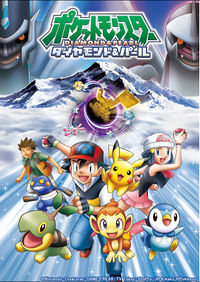
Just like with Kecleon in Generation III, the public learned of Generation IV through a new Pokémon — Munchlax — in May 2004. Munchlax was soon featured in Pokémon Dash, as well as the seventh movie and later the main anime. Others such as Lucario, Bonsly, Mime Jr., and Weavile then made their way to the eighth movie, and Mantyke, Buizel, and Chatot appeared in the ninth, which featured Manaphy — a new Mythical Pokémon that even became obtainable in Pokémon Ranger.
Diamond and Pearl Versions were eventually released for Nintendo DS in Japan on September 28, 2006, and in North America on April 22, 2007. Along with 107 new Pokémon in the new huge land of Sinnoh, these games offered a pseudo-3D rendering of the overworld, the return of the time system, visible gender differences between Pokémon, a split between physical and special moves, a new villainous team, known as Team Galactic and Pokémon Super Contests.
Pokémon the Series: Diamond and Pearl started in Japan and in the US in synchronization with the release of the games. Like the previous series, it introduced a new female character, Dawn, based on her game counterpart.
The first three movies of this series form a continuous trilogy. The first part of the trilogy, The Rise of Darkrai, premiered on July 14, 2007 in Japanese theaters, and aired on February 24, 2008 on North American televisions. The second part, Giratina and the Sky Warrior, premiered in Japan on July 19, 2008, and aired on February 13, 2009 on North American televisions. The third and final movie of the trilogy, Arceus and the Jewel of Life, premiered on July 18, 2009 in Japan, has aired on Cartoon Network in the United States on November 20, 2009.
A new TCG set was released in Japan on November 30, 2006 and in the United States on May 23, 2007, featuring the new Pokémon from Sinnoh.
New sequels
On December 14, 2006, two weeks after the launch of Nintendo's Wii console, Generation IV Pokémon turned 3D in the form of Pokémon Battle Revolution. It was released in the United States on June 25, 2007.
Several manga series were written for the fourth generation. The first volume of Pocket Monsters DP, the new sequel of Pokémon Pocket Monsters and Pokémon Ruby-Sapphire, was published in Japan on January 26, 2007. One month later, on February 27, Shigekatsu Ihara's Pokémon Diamond and Pearl Adventure! was first published.
The paired sequels for Pokémon Mystery Dungeon for Nintendo DS were released in Japan on September 13, 2007 and in North America on April 20, 2008. Just like before, an anime adaptation was also produced and a manga series was published.
Pokémon Rangers were also brought into the fourth generation in a sequel called Pokémon Ranger: Shadows of Almia, set in the new land of Almia. It was released in Japan on March 20, 2008 and in North America on November 10, 2008. An Anime special was also produced and aired on the same day as the Japanese release, and a short manga was posted as a webcomic on the Japanese Pokémon website. In March 6, 2010, another Ranger game, Pokémon Ranger: Guardian Signs was released in Japan. The new game set in the region of Oblivia was followed by several anime specials.
Like with Pokémon Box: Ruby and Sapphire in Generation III, a storage game titled My Pokémon Ranch was released on March 25, 2008 in Japan and on June 9, 2008 in North America, featuring the character of Hayley.
Another manga series, Miho Asada's Phantom Thief Pokémon 7 was collected and published on March 28, 2008. Pokémon Adventures then started its Diamond & Pearl arc with Volume 30 on December 25, 2008 and later the Platinum arc with the Volume 38 on February 28, 2011.
The third version of Generation IV, Platinum Version, was released on September 13, 2008 in Japan and on March 22, 2009 in North America, bringing new Pokémon forms into the ring for Giratina, Shaymin, and Rotom, as well as updates similar to those found in Pokémon Emerald.
Pokémon Mystery Dungeon: Explorers of Time and Explorers of Darkness was followed by a third version, Explorers of Sky, which was released in Japan on April 18, 2009. Just like the third versions of the core series, Explorers of Sky had additional content. Another anime adaptation was produced as well. Another set of games of the Pokémon Mystery Dungeon series was also produced for WiiWare, released in Japan on August 4, 2009.
Johto's Heart and Soul
Ever since the Generation III remakes for the incompatible Generation I Red and Green games, Pokémon fans have widely speculated that remakes of the Generation II Pokémon games, Gold and Silver, would be made for Nintendo DS. Indeed, the paired remakes, titled HeartGold and SoulSilver, were eventually released in Japan on September 12, 2009, and were released in the United States on March 14, 2010. The games were referred to in the anime in an episode that featured the counterpart of the new player character and the three first partner Pokémon of Johto, one of whom even joined the regular cast. A new expansion set for the TCG was also released to celebrate the new games.
Some manga series followed the release of the games, such as a new sequel to Pokémon Pocket Monsters, titled Pocket Monsters HGSS, of which the first volume was released in June 28, 2011. The HeartGold & SoulSilver arc of Pokémon Adventures was also released, with the first volume coming out in June 28, 2012.
A new game for the Wii: PokéPark Wii: Pikachu's Adventure, was released on December 5, 2009. The game was released in North America and Europe in the spring of 2010.
Generation V
A fresh start
On February 7, 2010, Pokémon Sunday revealed a new Pokémon: Zoroark. Generation V was dawning, and it quickly became clear that even though the new games, Pokémon Black and White, would again be on the Nintendo DS platform, everything about them would be quite new. In an unexpected move, Nintendo revealed that no old Pokémon would be available in the games until the main storyline had been completed, effectively giving both new and old Trainers in Unova, a region based on the New York City metropolitan area, rather than Japan, a completely fresh experience. On September 18, 2010, when the games were released in Japan, 156 new Pokémon were introduced, making this the biggest Pokémon generation yet.
Maintaining the innovations of Generation IV, Black and White added further to the time system that had been introduced more than ten years prior, now having the seasons change, and with them, Pokémon distribution and the time of day, with days being longer during summer and shorter during winter. The sprite animation system introduced in Generation III with Emerald was also done away with, returning Pokémon sprites to a system more like that of Crystal in Generation II - though now Pokémon move throughout the battle. Pokémon Contests have disappeared completely, with Pokémon Musical taking their place, though moves and conditions have no purpose in these competitions. Triple Battles, an expansion on the Double Battle concept introduced two generations prior, made position, as well as team cohesiveness, an important part of battle.
Unlike previous paired games, which generally differed only in Pokémon distribution, and ultimately, the availability of the Pokémon on the boxart at the conclusion of the main storyline, Black and White feature greater differences between the worlds of the opposite versions on level with those between paired and third version of earlier generations - Opelucid City in Black is highly technological, while in White it is laid-back and traditional, whereas two version-exclusive locations, Black City and White Forest, appear in the same location in their same-name version.
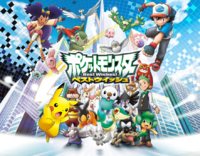
The anime was quick to follow with a new series, Pokémon the Series: Black & White. Unlike previous generations, no Pokémon from Generation V were shown in the closing episodes of Pokémon the Series: Diamond and Pearl, although the thirteenth movie, Zoroark Master of Illusions, featured Zorua and Zoroark as major characters, the only Generation V Pokémon featured prior to Best Wishes.
Similar to the original series, Ash's companions this time around are two Gym Leaders: Cilan and Iris. Like the games, Pokémon Journeys: The Series was also given a facelift. No Pokémon from previous generations (apart from Ash's Pikachu and Meowth) are shown in the episodes. Longtime anime characters, including the protagonist Ash Ketchum receive an upgraded appearance, most notably in regards to their eyes.
In an unprecedented move, two movies, rather than one, were released together as the fourteenth Pokémon movie, though the differences between the two are much alike the differences between Black Version and White Version.
Several manga series were released based on the games, such as a sequel to Pokémon Pocket Monsters, titled Pocket Monsters BW and Pocket Monsters BW: The Heroes of Fire and Thunder, among many others. Pokémon Adventures also jumped to the new generation, with the first volume of Black & White arc released in January 25, 2013.
It's a second step into Unova
It was always anticipated that Black and White would eventually get a third version, as past generations have. Many assumed it would be called "Pokémon Grey Version". However, this time there would be sequels, and with a different plot altogether.
Sequels to Black and White, Pokémon Black and White Versions 2, were released to Japan in June 2012 and came to North America, Europe and Australia in October 2012. The games feature two new forms of Kyurem, called Black Kyurem (Japanese: ブラックキュレム) and White Kyurem (Japanese: ホワイトキュレム), as well as new forms of the Forces of Nature and Keldeo. The games take place two years after Black and White, and many things have changed in the Unova region.
Some manga series followed the release of the second paired versions, most notably the Black 2 & White 2 arc of Pokémon Adventures which began its serialization in July 2013 (although a chapter featuring Hugh's backstory had been published prior to this).
Generation VI
The next evolution
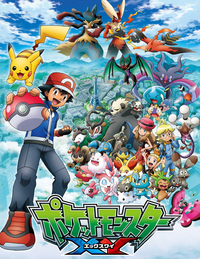
On January 8, 2013, Nintendo simultaneously announced to the world that a new generation of Pokémon will be coming to the world through a special edition of Nintendo Direct, called Pokémon Direct. Pokémon X and Y, the first games in Generation VI, were revealed and were released worldwide on October 12, 2013. These two games introduced several new Pokémon, and the Pokémon series took a new leap into the 3D world on the Nintendo 3DS. The concept of Mega Evolution was also introduced. During the unveiling of the new versions, three new first partner Pokémon were introduced: Grass Type Chespin, Fire Type Fennekin and Water Type Froakie. The games take place in a new region called Kalos, based on the real-world France. These games hearkened back to Generation I in several ways, by including many older Pokémon from different regions alongside a small amount of new ones, making older Pokémon stronger through Mega Evolution and introducing a brand-new type for the first time in over a decade. This generation marked the transition from 2D sprites to animated 3D models, a tradition that would continue in every following generation.
The anime was quick to follow with a new series, Pokémon the Series: XY. As with the previous three series, Pokémon the Series: XY began with Ash Ketchum, headed off to the new region with his Pikachu. His previous companions, Iris and Cilan, have left the series. Ash began his journey in Lumiose City. Clemont, Bonnie, and Serena having joined him in the series as companions.
Pokémon Adventures started the serialization of its X & Y arc following the games' release in October 2013. The first volume of a new series by Kosaku Anakubo, known as Pocket Monsters XY, was released on April 28, 2014.
Welcome back to Hoenn
Just like the Generation III remakes for the incompatible Generation I Red and Green games and the Generation IV remakes for the incompatible Generation II Gold and Silver games, Pokémon fans have widely speculated that remakes of the Generation III Pokémon games, Ruby and Sapphire, would be made for Nintendo 3DS. Indeed, the paired remakes, titled Omega Ruby and Alpha Sapphire, were revealed in a worldwide announcement on the official Pokémon websites on May 7, 2014 and were eventually released in Worldwide on November 21, 2014.
Twenty years of Pokémon
2016 officially marked the 20th anniversary of Pokémon, and it was celebrated with a re-release of the original Generation I core series games on the Nintendo 3DS's Virtual Console worldwide. These games were released on February 27, 2016, coinciding with Red and Green's original release date in Japan in 1996. In addition, there were further celebrations of the occasion throughout the year, such as rare Pokémon distributions and retail events.
Generation VII
Seven's a lucky number
The seventh generation of Pokémon was announced on February 27, 2016, the franchise's 20th anniversary with the new games Pokémon Sun and Moon and was released on November 18, 2016.
The anime was quick to follow with a new series, Pokémon the Series: Sun & Moon. As with the previous four series, Pokémon the Series: Sun & Moon began with Ash Ketchum, headed off to the new region with his Pikachu. His previous companions, Clemont, Bonnie and Serena, have left the series. Ash Ketchum heads off to a new region, Alola, wearing a new set of clothes with his partner Pikachu. He receives a Z-Ring and becomes a student at the Pokémon School on Melemele Island. Lillie, Kiawe, Mallow, Lana, and Sophocles joined him in the series as his classmates. For the first time in the anime's history, Ash wins a game-original Pokémon League and becomes a Champion.
The seventh generation broke several trends within the core series, such as abandoning HM moves, replacing Gyms with island challenge trials, and introducing Legendary Pokémon part of an evolutionary line.
A New Light Shines on Alola
Two follow-up games, Pokémon Ultra Sun and Ultra Moon, were announced during a Nintendo Direct presentation on June 6, 2017. The games were released exclusively on the Nintendo 3DS on November 17, 2017, featuring an alternate storyline set in Sun and Moon's world, and will feature new Pokémon not available in the original games.
Let's GO Back to Kanto Again with Pikachu and Eevee
On May 30, 2018, it was announced that two new Pokémon games in the main Pokémon franchise, Pokémon: Let's Go, Pikachu! and Let's Go, Eevee!, were going to be released on November 16, 2018. They are the first installments of the main Pokémon RPG series for Nintendo Switch and are inspired by Pokémon Yellow with gameplay mechanics borrowed from Pokémon GO.
Generation VIII
Forge a path to greatness
The eighth generation of Pokémon was announced with the reveal of Pokémon Sword and Shield on February 27, 2019. These games were released internationally on November 15, 2019. Fewer Pokémon were revealed prior to the game's release compared to other generations to increase anticipation.[9] These games introduced the Dynamaxing and Gigantamaxing features, while abandoning the Mega Evolution and Z-Move features introduced in previous generations. The games became the fastest selling Nintendo Switch games, beating out Super Smash Bros. Ultimate and selling 6 million copies worldwide.
Instead of releasing a separate "third version" or sequel(s) to Sword and Shield, a pair of DLCs, The Isle of Armor and The Crown Tundra, were introduced in its place, featuring all-new areas, returning Pokémon, and new Legendaries.
The anime was quick to follow with a new series, Pokémon Journeys: The Series, which took place in all of the regions from Kanto to Galar. It features two protagonists, Ash Ketchum and Goh, along with their partner Pikachu and Scorbunny. However, the COVID-19 pandemic caused the series to go on its first extensive hiatus in over 20 years.
Twenty-five years worth of memories
2021 was officially designated as the 25th anniversary of Pokémon, similarly to past celebrations in 2006 and 2016. In addition to several pieces of special merchandise, a music album featuring celebrity singers such as Katy Perry was announced in January.
Sinnoh Is Brilliant & Shiny
On February 26, 2021, Pokémon Brilliant Diamond and Shining Pearl, remakes of the Generation IV games Pokémon Diamond and Pearl, were announced on that day's Pokémon Presents and released on November 19, 2021. Pokémon Legends: Arceus, a title set in an earlier part of Sinnoh's history when it was known as Hisui, was also announced during same Pokémon Presents and released on January 28, 2022. The title notably focuses on catching Pokémon for research and is a purely single-player experience.
Generation IX
Yet another world to treasure
The ninth generation of Pokémon was announced with the reveal of Pokémon Scarlet and Violet on February 27, 2022, the first pair of mainline games to return to the classic tradition of naming versions after colors since the fifth generation. The main new features of the game are that the players can fully explore the region of Paldea without being forced to stick to a linear path, and the Terastal phenomenon that allows Pokémon to change their Type temporary. The games are the fastest selling titles in the series to date, having sold 10 million copies in the first three days of sales.
The anime, unlike previous generation, did not immediately debut with a new series alongside the games. On December 16, 2022, it was announced that Ash Ketchum, following his victory at the World Coronation Series, would have his story conclude in an 11-episode miniseries starting in January 2023. Then in April 2023, a brand new anime series will begin airing and star two brand new protagonists alongside the Paldea region first partner Pokémon.
See also
References
- ↑ http://www.glitterberri.com/pokemon-red-blue/early-concept-art/
- ↑ ポケモン10周年記念コラム
- ↑ Iwata Asks: Pokémon HeartGold Version & SoulSilver Version
- ↑ Beware of the Pokemania
- ↑ Iwata Asks: Pokémon HeartGold Version & SoulSilver Version
- ↑ スペシャル対談/3
- ↑ "[Mr. Yamauchi] indicated that the games would be customized for western markets, a process that should include new art for many of the monsters." Nintendo Power 104 (January 1998) p. 38 (retrieved December 21, 2010)
- ↑ Libération: Pokémon, traduisez-les tour.
- ↑ https://s.famitsu.com/news/201910/25185623.html


